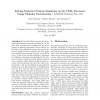Free Online Productivity Tools
i2Speak
i2Symbol
i2OCR
iTex2Img
iWeb2Print
iWeb2Shot
i2Type
iPdf2Split
iPdf2Merge
i2Bopomofo
i2Arabic
i2Style
i2Image
i2PDF
iLatex2Rtf
Sci2ools
TPDS
2008
2008
Solving Systems of Linear Equations on the CELL Processor Using Cholesky Factorization
: The STI CELL processor introduces pioneering solutions in processor architecture. At the same time it presents new challenges for the development of numerical algorithms. One is effective exploitation of the differential between the speed of single and double precision arithmetic; the other is efficient parallelization between the short vector SIMD cores. In this work, the first challenge is addressed by utilizing a mixed-precision algorithm for the solution of a dense symmetric positive definite system of linear equations, which delivers double precision accuracy, while performing the bulk of the work in single precision. The second challenge is approached by introducing much finer granularity of parallelization than has been used for other architectures and using a lightweight decentralized synchronization. The implementation of the computationally intensive sections gets within 90 percent of peak floating point performance, while the implementation of the memory intensive sections...
| Added | 15 Dec 2010 |
| Updated | 15 Dec 2010 |
| Type | Journal |
| Year | 2008 |
| Where | TPDS |
| Authors | Jakub Kurzak, Alfredo Buttari, Jack Dongarra |
Comments (0)

